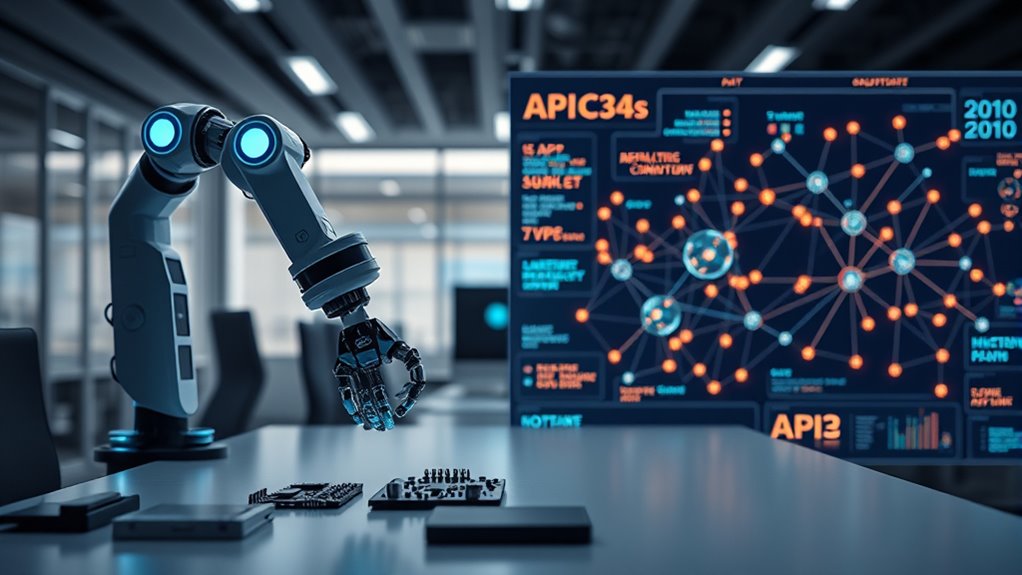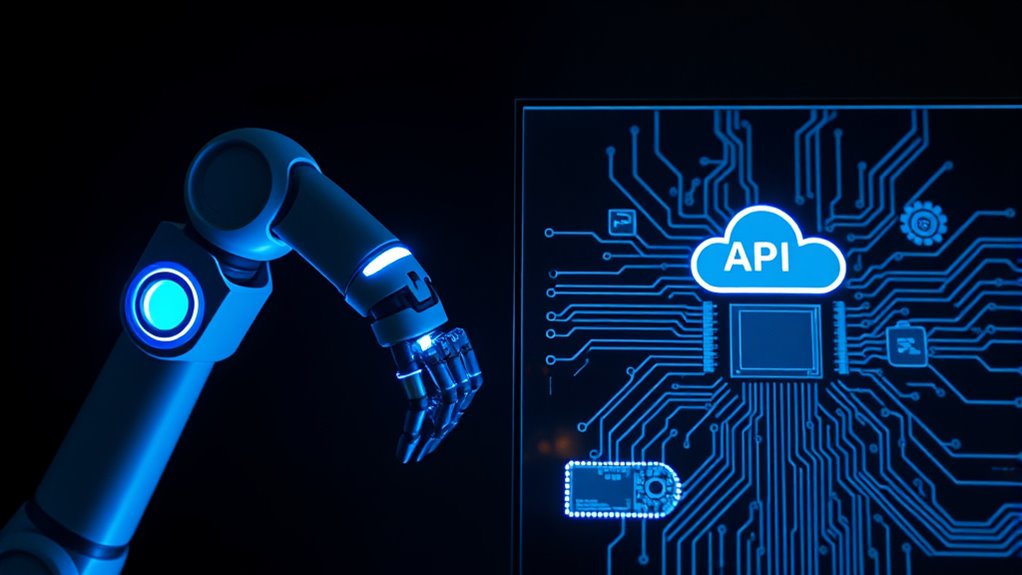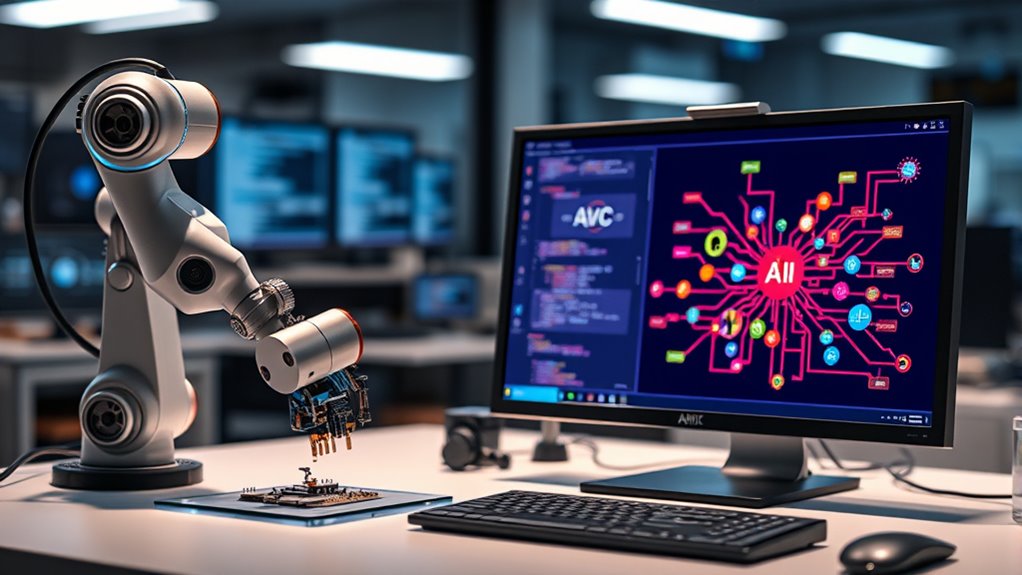Robotic Process Automation (RPA) mimics human actions at the user interface level to automate repetitive tasks, making it easy to implement and cost-effective for quick workflows. API automation connects systems via direct data exchange through APIs, offering more reliable, scalable, and real-time integration. While RPA suits legacy systems and simple tasks, API automation is better for complex, long-term needs. Understanding these differences can help you choose the right approach for your automation goals, and there’s more to explore ahead.
Key Takeaways
- RPA automates tasks via UI interactions, ideal for legacy systems and unstructured data, while API automation connects systems directly for faster data exchange.
- RPA is easier and cheaper to implement for repetitive, manual tasks; API automation offers scalability and reliability for complex workflows.
- RPA is suitable for short-term automation and quick deployment; API automation supports long-term, scalable, and real-time integrations.
- API automation provides better data control, security, and seamless workflow integration compared to RPA’s UI-based approach.
- Choosing between them depends on task complexity, system compatibility, scalability needs, and long-term automation goals.
Defining RPA and API Automation

Robotic Process Automation (RPA) and API automation are two ways to streamline business processes, but they operate quite differently. RPA mimics human actions to handle tasks across applications, focusing on workflow orchestration and user interface interactions. It’s ideal for automating repetitive tasks without needing complex integrations. On the other hand, API automation involves direct data integration between systems through application programming interfaces, enabling seamless, real-time data exchange. This approach allows for more precise control of data flows and reduces manual intervention. While RPA manages tasks at the user interface level, API automation connects backend systems directly. Both methods enhance efficiency but serve different roles in optimizing workflows, depending on whether your goal is task automation or robust data integration.
Key Differences in Functionality and Approach

While both RPA and API automation aim to improve efficiency, they approach tasks very differently. RPA mimics human actions, interacting with user interfaces to automate workflows, making it easy to integrate into existing systems without extensive programming. It’s ideal for tasks that involve legacy applications or unstructured data. In contrast, API automation connects systems directly through standardized interfaces, enabling seamless workflow integration and faster, more reliable data exchanges. Security considerations differ markedly: APIs often incorporate built-in authentication, encryption, and access controls, while RPA may require additional safeguards due to its UI-based approach. Understanding these differences helps you choose the right method based on your workflow needs, system architecture, and security requirements.
Advantages and Limitations of Each Method

Both RPA and API automation offer distinct advantages that can markedly boost your operational efficiency, but they also come with limitations you should consider. RPA excels in cost efficiency for automating repetitive tasks without needing extensive development, making it quick to deploy. However, it can struggle with scalability, especially as processes grow more complex or require frequent updates. API automation provides high scalability, allowing you to integrate systems seamlessly and handle larger workloads efficiently. It often offers better reliability and speed but may involve higher initial costs and development effort. While RPA is more accessible for short-term automation, API automation is more suitable for long-term, scalable solutions. Understanding these advantages and limitations helps you choose the right method for your specific needs, especially as AI-powered virtual reality in e-learning continues to transform how automation integrates with innovative technologies.
Suitable Use Cases and Scenarios

Choosing the right automation method depends on your specific needs and the complexity of your processes. For workflow optimization, RPA excels in automating repetitive tasks across legacy systems without extensive integration. Use RPA when:
- You need to handle multiple applications with inconsistent interfaces.
- Tasks involve manual data entry or repetitive workflows.
- Speed is essential for process completion.
- Integration challenges with existing systems are significant.
- RPA can leverage cookie-based automation to enhance user experience and streamline operations.
API automation suits scenarios requiring seamless data exchange between modern, connected systems. Opt for API automation when:
- You want real-time data synchronization.
- Processes depend on well-defined, stable APIs.
- You aim to reduce manual intervention in API-driven workflows.
- You need scalable, future-proof integrations, minimizing workflow disruption.
Factors to Consider When Choosing an Automation Strategy

Selecting the right automation strategy requires careful consideration of several key factors that influence its effectiveness and long-term success. First, evaluate the cost implications; some solutions may have higher upfront costs but offer better ROI over time. Consider scalability challenges; ensure the chosen approach can grow with your business without requiring complete overhauls. Compatibility with existing systems also matters—whether RPA or API automation fits seamlessly into your infrastructure. Additionally, assess the complexity of tasks you want to automate; simple processes might benefit from RPA, while more dynamic integrations could require API automation. Finally, think about maintenance and support needs, as well as future growth plans, to select an approach that balances initial investment with future flexibility. Incorporating high-quality content can help inform your decision-making process and ensure a comprehensive understanding of your options.
Frequently Asked Questions
How Do RPA and API Automation Impact Overall IT Infrastructure?
You see how RPA and API automation influence your IT infrastructure by enabling AI integration and boosting data scalability. RPA automates repetitive tasks, freeing resources, while API automation streamlines data exchange between systems. Together, they make your infrastructure more flexible and efficient, allowing for smoother integration of new technologies. This synergy enhances your ability to scale data processes rapidly, ensuring your IT setup stays agile and responsive to evolving business needs.
What Are the Security Risks Associated With Each Automation Method?
When considering automation methods, you need to be aware of security risks like data breaches and unauthorized access. RPA can expose sensitive data if bots aren’t properly secured, leading to potential breaches. API automation, on the other hand, may be vulnerable to hacking if APIs aren’t correctly managed or authenticated. You should implement strict access controls and monitor your systems closely to mitigate these risks effectively.
Can RPA and API Automation Be Integrated Within the Same Workflow?
Yes, you can integrate RPA and API automation within the same workflow. To do this successfully, you need to take into account workflow integration and tool compatibility. Combining these methods allows you to automate complex processes more efficiently, leveraging RPA for user interface interactions and APIs for direct data exchange. Ensure your tools are compatible and well-integrated to achieve seamless automation, resulting in increased efficiency and reduced manual effort.
How Do Costs Compare for Implementing RPA Versus API Automation?
Imagine weighing two treasure chests—you’ll find that API automation often requires a smaller, more manageable investment, like planting seeds that grow steadily. RPA, however, can be a heavier financial burden upfront, like building a fortress. When doing a cost comparison, consider the investment analysis carefully; API automation usually costs less initially, but RPA might justify higher costs with broader automation capabilities. Choose based on your budget and long-term goals.
What Skills Are Required to Develop and Maintain Each Automation Type?
You need different skill requirements for developing and maintaining each automation type. For RPA, you should have skills in scripting, process analysis, and understanding user interfaces. API automation demands knowledge of programming languages like Python or Java, and experience working with APIs and data formats. Maintenance challenges include troubleshooting, updates, and integration issues, which require ongoing technical expertise to guarantee smooth operation and adapt to system changes.
Conclusion
Ultimately, choosing between RPA and API automation depends on understanding your needs, evaluating your environment, and aligning your goals. You seek flexibility and ease? RPA offers visual, user-friendly solutions. You prioritize speed and accuracy? API automation delivers seamless, efficient integrations. Consider your resources, your technical landscape, and your desired outcomes. By weighing these factors, you can select the right approach, optimize your processes, and achieve automation success that empowers your organization and drives growth.









